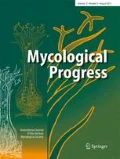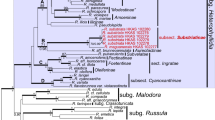Abstract
Rhizomorpha corynecarpos Kunze was originally described from wet forests in Suriname. This unusual fungus forms white, sterile rhizomorphs bearing abundant club-shaped branches. Its evolutionary origins are unknown because reproductive structures have never been found. Recent collections and observations of R. corynecarpos were made from Belize, Brazil, Ecuador, Guyana, and Peru. Phylogenetic analyses of three nuclear rDNA regions (internal transcribed spacer, large ribosomal subunit, and small ribosomal subunit) were conducted to resolve the phylogenetic relationship of R. corynecarpos. Results show that this fungus is sister to Brunneocorticium bisporum—a widely distributed, tropical crust fungus. These two taxa along with Neocampanella blastanos form a clade within the primarily mushroom-forming Marasmiaceae. Based on phylogenetic evidence and micromorphological similarities, we propose the new combination, Brunneocorticium corynecarpon, to accommodate this species. Brunneocorticium corynecarpon is a pathogen, infecting the crowns of trees and shrubs in the Neotropics; the long, dangling rhizomorphs with lateral prongs probably colonize neighboring trees. Longer-distance dispersal can be accomplished by birds as it is used as construction material in nests of various avian species.



Similar content being viewed by others
References
Aime MC, Phillips-Mora W (2005) The causal agents of witches’ broom and frosty pod rot of cacao (chocolate, Theobroma cacao) form a new lineage of Marasmiaceae. Mycologia 97:1012–1022
Antonín V (2007) Fungus Flora of tropical Africa, Volume 1: Monograph of Marasmius, Gloiocephala, Palaeocephala and Setulipes in Tropical Africa. National Botanic Garden, Belgium
Aubrecht G, Huber W, Weissenhofer A (2013) Coincidence or benefit? The use of Marasmius (horse-hair fungus) filaments in bird nests. Avian Biol Res 6:26–30
Berkeley MJ (1856) Decades of fungi. Decades LXI–LXII. Rio Negro fungi. Hooker’s J Bot Kew Gard Misc 8:272–280
Berlese AN (1892) Rapporti tra Dematophora e Rosellinia. Riv Patol Veg 1:5–17
Boddy L (1993) Saprotrophic cord-forming fungi: warfare strategies and other ecological aspects. Mycol Res 97:641–655
Boidin J, Lanquetin P, Duhem B (1996) Contribution à la connaissance du genre Dendrothele (Basidiomycotina, Aphyllophorales). Bull Trimest Soc Mycol Fr 112:87–126
Bonito G, May TW (2014) Barcoding of Australian fungi. NCBI GenBank. https://www.ncbi.nlm.nih.gov/genbank/. Accessed 4 June 2018
Burdsall HH Jr, Nakasone KK (1983) Species of effused Aphyllophorales (Basidiomycotina) from the southeastern United States. Mycotaxon 17:253–268
Burt EA (1918) Corticiums causing Pellicularia disease of the coffee plant, hypochnose of pomaceous fruits, and Rhizoctonia disease. Ann Mo Bot Gard 5:119–132
Cairney JWG (1991a) Rhizomorphs: organs of exploration or exploitation? Mycologist 5:5–10
Cairney JWG (1991b) Rhizomorph structure and development in Marasmius crinisequi. Mycol Res 95:1429–1432
Ceresini PC, Costa-Souza E, Zala M, Furtado EL, Souza NL (2012) Evidence that the Ceratobasidium-like white-thread blight and black rot fungal pathogens from persimmon and tea crops in the Brazilian Atlantic Forest agroecosystem are two distinct phylospecies. Genet Mol Biol 35:480–497
Dentinger BTM, Gaya E, O’Brien H, Suz LM, Lachlan R, Díaz-Valderrama JR, Koch RA, Aime MC (2016) Tales from the crypt: genome mining from fungarium specimens improves resolution of the mushroom tree of life. Biol J Linnean Soc 117:11–32
Donk MA (1962) The generic names proposed for Agaricaceae. Beih Nova Hedwigia 5:1–320
Edgar RC (2004) MUSCLE: multiple sequence alignment with high accuracy and high throughput. Nucleic Acids Res 32:1792–1797
Freymann BP (2008) Physical properties of fungal rhizomorphs of marasmioid basidiomycetes used as nesting material by birds. Ibis 150:395–399
Gardes M, Bruns TD (1993) ITS primers with enhanced specificity for basidiomycetes—application to the identification of mycorrhizae and rusts. Mol Ecol 2:113–118
Golley FB (1983) Decomposition. In: Golley FB (ed) Tropical Rain Forest Ecosystems. Structure and Function. Elsevier Scientific Publishing Company, Amsterdam, pp 157–166
Gónzalez D, Rodriguez-Carres M, Boekhout T, Stalpers J, Kuramae EE, Nakatani AK, Vilgalys R, Cubeta MA (2016) Phylogenetic relationships of Rhizoctonia fungi within the Cantharellales. Fungal Biol 120:603–619
Granlund HI, Jennings DH, Thompson W (1985) Translocation of solutes along rhizomorphs of Armillaria mellea. Trans Br Mycol Soc 84:111–119
Hedger J (1990) Fungi in the tropical forest canopy. Mycologist 4:200–202
Hedger J, Lewis P, Gitay H (1993) Litter-trapping by fungi in moist tropical forest. In: Isaac S, Frankland JC, Watling R, AJS W (eds) Aspects of Tropical Mycology. Cambridge University Press, Cambridge, pp 15–36
Henkel TW (2003) Monodominance in the ectomycorrhizal Dicymbe corymbosa (Caesalpiniaceae) from Guyana. J Trop Ecol 19:417–437
Henkel TW, Aime MC, Chin MML, Miller SL, Vilgalys R, Smith ME (2012) Ectomycorrhizal fungal sporocarp diversity and discovery of new taxa in Dicymbe monodominant forests of the Guiana shield. Biodivers Conserv 21:2195–2220
Hennings P (1904) Fungi Amazonici a cl. Ernesto Ule collecti III Hedwigia 43:351–400
Hu CC (1984) Horse-hair blight, new disease of tea bush caused by Marasmius equicrinis Mull in Taiwan. Taiwan Tea Res Bull 3:1–4
Isaacs R, Gillman MP, Johnston M, Marsh F, Wood BC (1996) Size structure of a dominant Neotropical forest tree species, Dicymbe altsonii, in Guyana and some factors reducing seedling leaf area. J Trop Ecol 12:599–606
Koch RA, Wilson AW, Séné O, Henkel TW, Aime MC (2017) Resolved phylogeny and biogeography of the root pathogen Armillaria and its gasteroid relative, Guyanagaster. BMC Evol Biol 17:33
Lanfear R, Calcott B, Ho SY, Guindon S (2012) Partitionfinder: combined selection of partitioning schemes and substitution models for phylogenetic analyses. Mol Biol Evol 29:1695–1701
Matheny PB, Hibbett DS (2005) Assembling the fungal tree of life. NCBI GenBank. https://www.ncbi.nlm.nih.gov/genbank/. Accessed 4 June 2018
Matheny PB, Bougher NL, Hibbett DS (2004) Assembling the fungal tree of life. NCBI GenBank. https://www.ncbi.nlm.nih.gov/genbank/. Accessed 4 June 2018
Matheny PB, Curtis JM, Hibbett DS (2006a) Assembling the fungal tree of life. NCBI GenBank. https://www.ncbi.nlm.nih.gov/genbank/. Accessed 4 June 2018
Matheny PB, Curtis JM, Hofstetter V, Aime MC, Moncalvo JM, Ge ZW, Slot JC, Ammirati JF, Baroni TJ, Bougher NL, Hughes KW, Lodge DJ, Kerrigan RW, Seidl MT, Aanen DK, DeNitis M, Daniele GM, Desjardin DE, Kropp BR, Norvell LL, Parker A, Vellinga EC, Vilgalys R, Hibbett DS (2006b) Major clades of Agaricales: a multilocus phylogenetic overview. Mycologia 98:982–995
Moncalvo JM, Lutzoni FM, Rehner SA, Johnson J, Vilgalys R (2000) Phylogenetic relationships of agaric fungi based on nuclear large subunit ribosomal DNA sequences. Syst Biol 49:278–305
Moncalvo JM, Vilgalys R, Redhead SA, Johnson JE, James TY, Aime MC, Hofstetter V, Verduin SJ, Larsson E, Baroni TJ, Thorn RG, Jacobsson S, Clémençon H, Miller OK Jr (2002) One hundred and seventeen clades of euagarics. Mol Phylogenet Evol 23:357–400
Nakasone KK, Hibbett DS, Goranova G (2009) Neocampanella, a new corticioid fungal genus, and a note on Dendrothele bispora. Botany 87:875–882
Pegler DN (1983) Agaric flora of the lesser Antilles. Kew Bull Add Ser 9:1–668
Ronquist F, Teslenko M, van der Mark P, Ayres DL, Darling A, Höhna S, Larget B, Liu L, Suchard MA, Huelsenbeck JP (2012) MrBayes 3.2: efficient Bayesian phylogenetic inference and model choice across a large model space. Syst Biol 61:539–542
Roth AG (1791) Vegetabilia cryptogamica minus hucusque cognita. Ann Bot Usteri 1:5–12
Sick H (1957) Roßhaarpilze als Nestbau-Material brasilianischer Vögel. J Ornithol 98:421–431
Singleton DR, Harper RG (1998) Bacteria in old house wren nests. J Field Ornithol 69:71–74
Stalpers J, Redhead S, Rossman A, Cubeta M, Kirschner R, Lange G, Larsson K-H, Norvell L, Oberwinkler F, Rajchenberg M, Roberts P, Thorn RG, et al (in press) Recommendations of fungal genera competing for use: Agaricomycotina (Basidiomycota). IMA Fungus
Stamatakis A (2006) RAxML-VI-HPC: maximum likelihood-based phylogenetic analyses with thousands of taxa and mixed models. Bioinformatics 22:2688–2690
Su HJ, Thseng FM, Chen JS, Ko W-H (2011) Production of volatile substances by rhizomorphs of Marasmius crinisequi and its significance in nature. Fungal Divers 49:199–202
Tamura K, Peterson D, Peterson N, Stecher G, Nei M, Kumar S (2011) MEGA5: molecular evolutionary genetics analysis using maximum likelihood, evolutionary distance, and maximum parsimony methods. Mol Biol Evol 28:2731–2739
Thompson W (1984) Distribution, development and functioning of mycelial cord systems of decomposer basidiomycetes of the deciduous woodland floor. In: Jennings DH, ADM R (eds) The Ecology and Physiology of the Fungal Mycelium. Cambridge University Press, Cambridge, pp 185–214
Thompson W, Rayner ADM (1983) Extent, development and function of mycelial cord systems in soil. Trans Br Mycol Soc 81:333–345
Vinnere O, Fatehi J, Sivasithamparam K, Gerhardson B (2005) A new plant pathogenic sterile white basidiomycete from Australia. Eur J Plant Pathol 112:63–77
Wakefield EM (1934) Contributions to the flora of tropical America: XXI. Fungi collected in British Guiana, chiefly by the Oxford university expedition, 1929. Bull Misc Inform Kew 1934:238–258
White TJ, Bruns T, Lee S, Taylor TW (1990) Amplification and direct sequencing of fungal ribosomal RNA genes for phylogenetics. In: Innis MA, Gelfand DH, Sninsky JJ, White TJ (eds) PCR protocols: a guide to methods and applications. Academic Press, London, pp 315–322
Wood TM, Gallo F, Donahue PK (1992) Observations at a paradise tanager nest. Wilson Bull 104:360–362
Wu SH, Wang DM, Tschen E (2007) Brunneocorticium pyriforme, a new corticioid fungal genus and species belonging to the euagarics clade. Mycologia 99:302–309
Acknowledgements
The authors wish to thank David Hibbett, Tim Baroni, and one anonymous reviewer for their helpful comments on this manuscript; Chris Andrew, Francino Edmund, Justin Edmund, Peter Joseph, and Ramkin Joseph for the assistance in the field; NSF DDIG (DEB-1501782), NSF DEB-1556412, NSF DEB-0103621, the Mycological Society of America Undergraduate Research Award, and USDA Hatch #1010662 for the financial resources; Richard C. Hoyer/Birdernaturalist and Joseph M. Wunderle, Jr. who graciously provided photographs; and Amy Rossman, Drew Minnis, Shannon Dominick, and Melanie Schori for assistance in resolving the nomenclature issues related to R. corynecarpos.
Author information
Authors and Affiliations
Corresponding author
Ethics declarations
Conflict of interest
The authors declare that they have no conflict of interest.
Additional information
Section Editor: Zhu-Liang Yang
Rights and permissions
About this article
Cite this article
Koch, R.A., Jean Lodge, D., Sourell, S. et al. Tying up loose threads: revised taxonomy and phylogeny of an avian-dispersed Neotropical rhizomorph-forming fungus. Mycol Progress 17, 989–998 (2018). https://doi.org/10.1007/s11557-018-1411-8
Received:
Revised:
Accepted:
Published:
Issue Date:
DOI: https://doi.org/10.1007/s11557-018-1411-8




